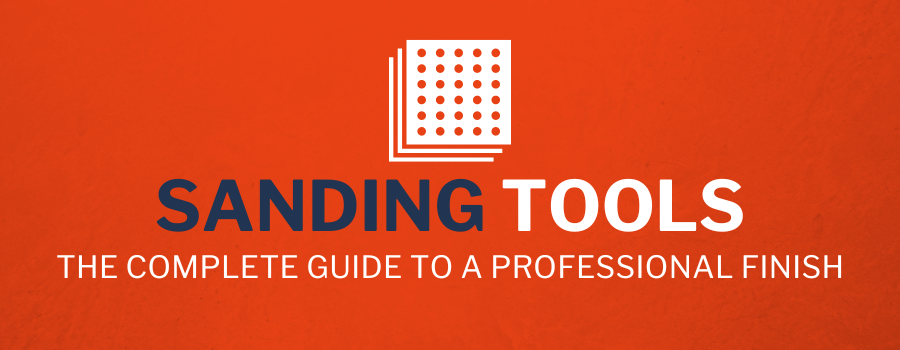- Essential Sanding Basics
- Manual Sanding Tools
- Power Sanding Solutions
- Sanding Safety & Cleanup
- Sanding Tools Summarised
Achieving a perfectly smooth surface is the cornerstone of a professional finish. The right sanding tools are imperative to avoid imperfections at the finished result.
Today, there are lots of different sanding tools available that are designed to reach every corner of your project. These tools help you achieve a professional finish that meets high standards.
Having a variety of tools is important, but knowing how to use them properly is key to getting the best results.
Essential Sanding Basics

To get a perfect finish, it’s important to know about the sandpaper grit scale. This scale tells you how rough or smooth the sanding tools are.
You choose between coarse, medium, and fine grits depending on what you need for your plaster surface. Coarse grits are good for removing material fast, while fine grits give you that extra smooth finish.
It’s also really important to think about dust extraction and dust-free sanding systems. These help keep your work area clean and protect your health.
Choosing the Right Grit
Choosing the right sandpaper grit is important if you want a smooth surface. Start with coarse grits to get rid of a lot of material quickly, then switch to finer grits to make it even smoother.
When you’re getting close to the finish line, go for grits that gradually get finer. This way, you’ll refine the surface step by step, without skipping any important parts of the sanding process.
Remember, lower grit numbers mean coarser sandpaper that’s good for heavy-duty material removal.
It’s all about the progression: coarse grits prep the surface, medium grits smooth out transitions, and fine grits give you that perfect final touch. Each step sets you up for the next one, so you can achieve a professional-grade finish.
Sanding Techniques
To get a perfect finish, you need to use the right sanding techniques and follow the grit progression. If you’re not careful, you might end up with an uneven and unsatisfactory surface.
When sanding by hand, use a flexible sanding block to apply consistent pressure. This is especially important on corners and edges to avoid uneven spots or gouges.
When using a power sander, be gentle and don’t press too hard. Keep the machine moving smoothly to distribute the sanding evenly. Also, make sure to sand in the same direction to minimise scratches and achieve a professional finish.
Remember, being patient and paying attention to the grain of the material is key to getting a great end result.
Manual Sanding Tools

Manual sanding tools are a must-have for getting a smooth finish on different surfaces.
You’ve got your sandpaper sheets, sanding blocks, and even tools like contour sanders and drywall sanding sponges. The range of manual sanding tools is diverse and they really get the job done.
Using manual sanding tools gives you total control and precision, which is especially important for detailed work or tight spaces where power tools might be too strong. You need a steady hand and a good understanding of the material to avoid messing up the surface.
Sanding Blocks Simplified
Sanding blocks are essential for getting that smooth and polished look by hand.
They’re simple but effective tools that help you achieve a flat and smooth surface, which is crucial for a professional finish. By evenly distributing pressure on the sandpaper, they make sanding more efficient and give you better results. Unlike power sanders, they won’t accidentally sand too much or create uneven textures. So, you can trust them to keep the surface looking its best.
Sanding blocks are great for all kinds of materials and won’t break the bank.
They’re easy to use and cost-effective. Just hold onto them tightly and move them back and forth over the surface. They’re handy for sanding flat and curved areas because they can adapt to different shapes. Wrap them with the right sandpaper and they become an essential tool in any professional’s sanding kit.
And the best part? You can easily refresh them by changing the sandpaper.
Over time, they might wear out a bit, but you can simply replace the sandpaper and they’re good as new. This makes them a durable and eco-friendly option too.
Adding sanding blocks to your toolkit will level up your sanding game, make your work more efficient, and support sustainable practices. Plus, they’re a budget-friendly alternative to power sanders, without sacrificing that professional finish.
Whether you’re a DIY enthusiast or a pro, sanding blocks are a smart investment for achieving top-notch surface preparation and finishing.
Different Shapes for Different Tasks
When it comes to sanding, the shape of your tool makes a big difference in getting that perfect finish.
- Block Sanders – Great for flat surfaces and edges.
- Detail Sanders – Perfect for getting into tight corners and intricate areas.
- Random Orbital Sanders – Best for giving larger flat areas a smooth and swirl-free finish.
- Belt Sanders – Used for quickly removing a lot of material on big, flat surfaces.
- File Sanders – Perfect for narrow spaces and sharp edges.
- Contour Sanders – Designed to easily sand curves and shapes.
Choosing the right shape of sander is important for getting the job done efficiently and getting a high-quality result.
Different projects call for different sanding tools, so it’s important to understand what each one is best for.
Power Sanding Solutions

When you need fast and consistent results, power sanders are a game-changer. They combine speed and precision to make sanding a breeze. With different abrasive grades, electric sanders are a must-have for professionals, especially when dealing with large surface areas.
Choosing the right power sander is like picking the perfect brush for a masterpiece. Orbital sanders give wood a smooth finish, while belt sanders are great for heavy-duty material removal.
Picking the right tool is key to making sanding easier and more efficient. Skilled operators can use these tools to make surfaces super smooth, ready for paint or varnish.
Electric Sanding Tools Explained
Electric sanders bring precision and power to the table, making sanding a breeze. With electric operation, you can say goodbye to the physical strain and focus on getting that perfect finesse.
There’s a wide variety of electric sanders available, each designed for specific needs and materials.
From the delicate touch of random orbital sanders to the aggressive power of belt sanders, these tools are engineered to perform their best in their own niche.
Whether you’re a professional or a DIY enthusiast, knowing about these tools is crucial for getting a super smooth surface.
Investing in an electric sander means investing in quality and efficiency.
Features like variable speed control, dust extraction systems, and ergonomic designs make sanding a more enjoyable and productive experience. With the right electric sander, you can complete time-consuming projects to a higher standard in a fraction of the time.
Battery-Powered Versatility
Cordless sanders are a game-changer in the workshop.
They give you unmatched mobility since you’re not tied down to power outlets or extension cords. This means you can work anywhere, which is a game-changer for professionals who need to move around a lot. When it comes to outdoor or on-site projects, battery-powered sanders are a lifesaver.
Battery technology has come a long way.
Modern cordless sanders are a testament to this progress. They use lithium-ion batteries that offer longer run times and consistent power output. So, even during long periods of use, you can count on reliable performance without the power fading as the battery charge goes down.
Swap batteries, keep the momentum going.
Investing in a cordless sanding system, especially from a brand that offers batteries that work with multiple tools, ensures that your workflow won’t be interrupted. Having multiple batteries means you can use one while another charges, so you can keep making progress on those long sanding tasks.
Battery capacity keeps getting better.
Thanks to advancements in battery technology, sanding tools can now have higher capacity and efficiency. Manufacturers are still focused on finding the perfect balance between lightweight design and powerful output to enhance the user experience.
Sanding Safety and Cleanup

When you’re sanding, it’s really important to protect yourself with the right gear.
Make sure to wear a dust mask or respirator, safety goggles, and hearing protection. This will keep you safe from inhaling harmful dust and protect your eyes and ears from the noise and debris.
To keep the workspace safe, it’s crucial to clean regularly. Use an industrial vacuum cleaner with a fine dust filter to prevent the buildup of combustible dust. This will help maintain a safe environment.
In addition to wearing protective gear, it’s a good idea to have good ventilation in the sanding area. You can use a dust extraction system or a fan to help disperse airborne particles and reduce the risk of respiratory issues.
After you’re done sanding, it’s important to clean up properly. This not only shows professionalism, but also minimises the chance of dust affecting future finishes.
Protective Gear Must-Haves
Putting your personal safety first is key when it comes to sanding.
Here is some important safety gear to consider:
- Safety Goggles: Protect your eyes from airborne particles.
- Dust Mask or Respirator: Prevent inhalation of harmful dust.
- Hearing Protection: Keep your ears safe from loud noise.
- Protective Gloves: Get a good grip and protect your hands.
- Long-Sleeved Clothing: Cover up to minimise dust on your skin.
Choosing the right safety gear is crucial, especially for long sanding sessions.
Using the proper protective equipment shows professionalism and care.
Efficient Dust Management
Keeping dust under control is crucial for maintaining a clean work environment and protecting your health.
Choosing the right dust extractor that matches your tool’s specifications is essential for effective dust management and a smoother sanding process.
Since 2010, sanding technology has improved with integrated dust extraction systems.
These systems work together with the tool to collect dust as you work, keeping the surface clean.
This is especially valuable for professionals who need precise results and DIY enthusiasts who want a high-quality finish.
To take a proactive approach to dust management, you can use anti-static sanding sheets or meshes.
These materials are designed to reduce dust sticking to the workpiece, giving you a cleaner surface and a healthier breathing environment. This also improves visibility and accuracy while sanding.
Proper maintenance of your equipment is also important for effective dust management. Regularly clean filters, check for proper seals, and replace dust bags as needed.
A well-maintained system reduces downtime and prevents the spread of fine dust particles in your workspace.
Remember, excellent dust control not only shows your attention to detail but also demonstrates your commitment to health, safety, and producing top-notch work.
Sanding Tools Summarised

Getting a flawless finish requires the right sanding tools.
A professional plasterer needs a variety of sanders in their toolkit, like orbital, belt, and hand sanders. Each one has its own purpose. For example, orbital sanders are great for large, flat surfaces, while hand sanders or detail sanders are perfect for detailed and intricate areas.
Using the right tool is key to getting precise results.
Factors like the grit size and type of sander can make a big difference in the outcome of your project. It’s important to choose a tool that feels comfortable to use and has good vibration control to prevent fatigue during long periods of sanding.
Investing in quality tools is important for durability and reliable performance.
The sanding landscape is always evolving, with new technologies and designs. These advancements offer more efficient and user-friendly options that can handle different textures and meet specific project requirements. They give you the precision you need to achieve a professional finish.

